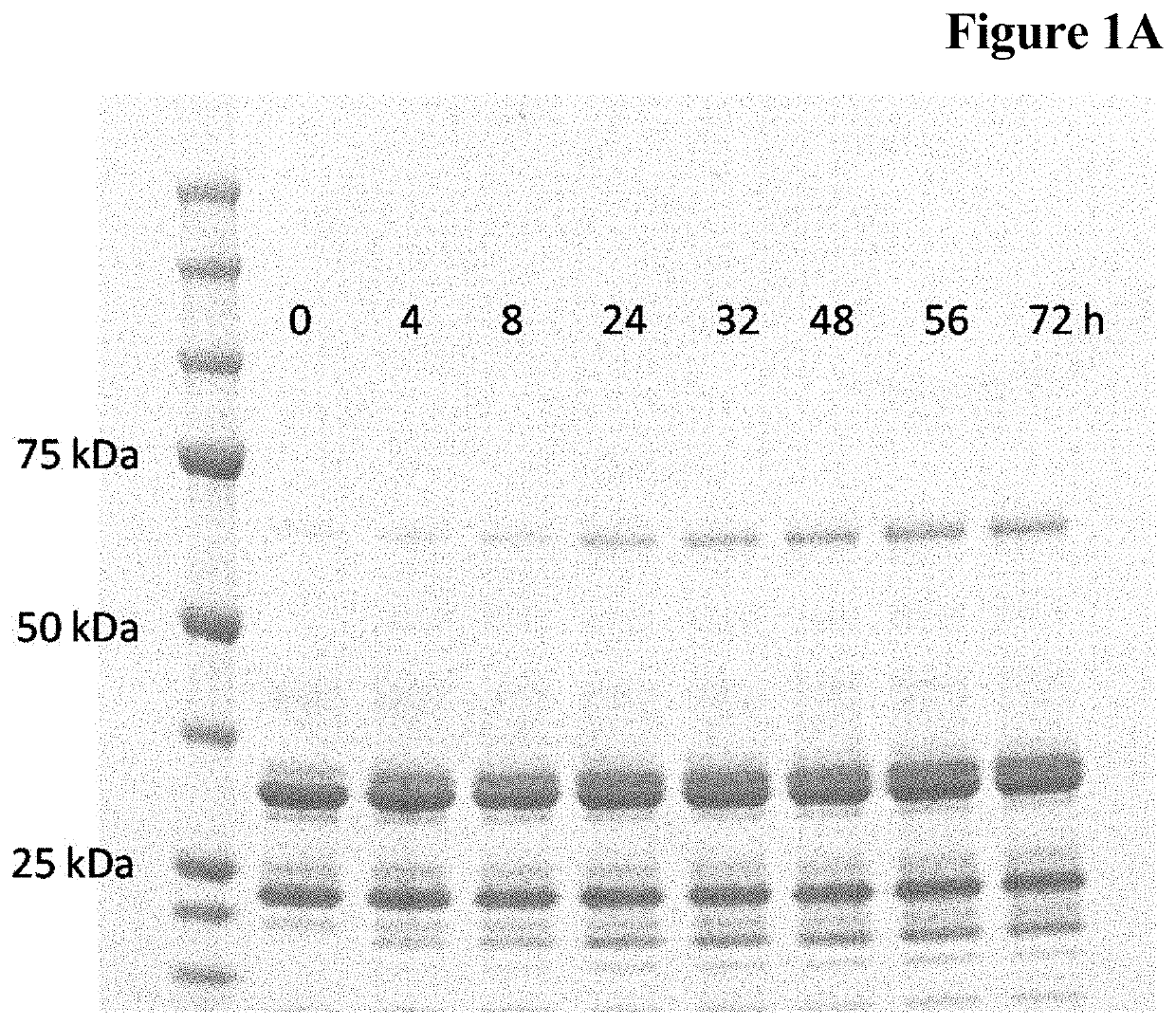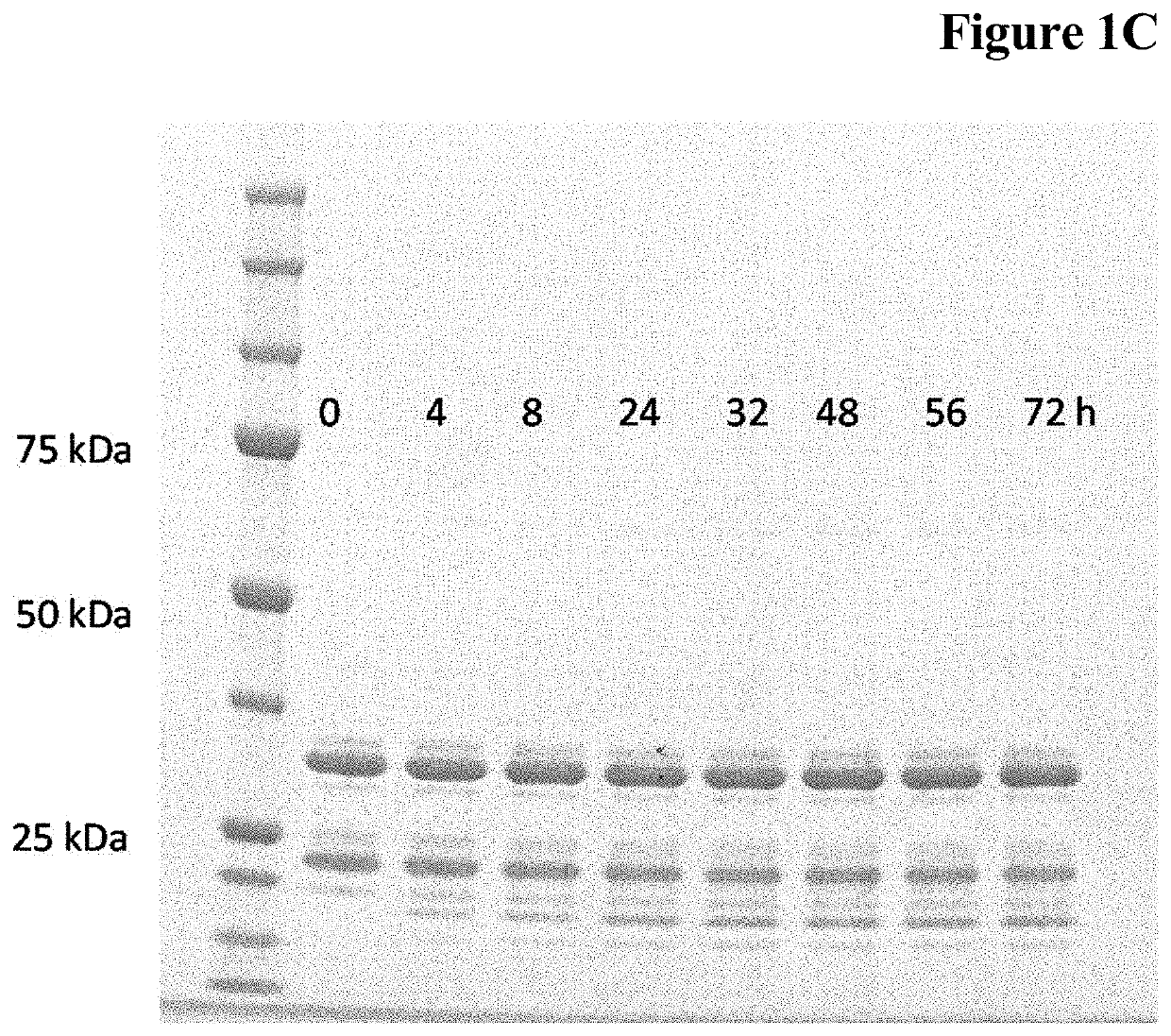Enzymatic one-pot reaction for double polypeptide conjugation in a single step
a one-pot reaction and polypeptide technology, applied in the field of enzymatic one-pot reaction for double polypeptide conjugation in a single step, can solve the problems of lpxta motif refractory to cleavage, strep /sub, albeit with reduced efficiency
- Summary
- Abstract
- Description
- Claims
- Application Information
AI Technical Summary
Benefits of technology
Problems solved by technology
Method used
Image
Examples
example 1
Generation of an Expression Plasmid for Soluble S. aureus Sortase A
[0149]The sortase gene encodes an N-terminally truncated Staphylococcus aureus sortase A molecule (amino acid sequence of SEQ ID NO: 21).
[0150]The expression plasmid for the expression of soluble sortase in E. coli cells comprised besides the soluble sortase expression cassette an origin of replication from the vector pUC18, which allows replication of this plasmid in E. coli, and the URA3 gene as selectable marker, and the Lad gene to allow induction of transcription using IPTG.
[0151]The transcription unit of the soluble sortase comprised the following functional elements:[0152]a T5 promoter,[0153]a purification tag,[0154]an N-terminally truncated S. aureus sortase A encoding nucleic acid, and[0155]the To and fd termination sequences.
[0156]The amino acid sequence of the mature soluble sortase A derived from Staphylococcus aureus is
[0157]
(SEQ ID NO: 21)QAKPQIPKDKSKVAGYIEIPDADIKEPVYPGPATPEQLNRGVSFAEENESLDDQNISIAGHTFID...
example 2
Expression and Analytical Characterization of Sortase
[0161]The recombinant production of soluble Sortase was performed by growing E. coli cells transformed with the respective Sortase expression plasmids to an OD578 of approx. 0.9 at 37° C. (pre-culture). At this OD578 of approx. 0.9 protein expression was induced by adding 2 mM IPTG and growing the cells for an additional 24 hours at 28° C. Thereafter, cells were harvested by centrifugation and lysed via high pressure using a homogenizer. Cell lysates were centrifuged to remove cell debris and subsequently the cell lysates were stored at reduced temperature (e.g. −80° C.) until purification. Soluble Sortase was purified using Ni-NTA chromatography followed by size exclusion chromatography. For depletion of endotoxins an anion exchange chromatography was performed in flow through mode. The protein concentration of sortase preparations was determined by measuring the optical density (OD) at 280 nm, using the molar extinction coeffici...
example 3
Generation of an Expression Plasmid for C-Terminally Modified Fc-Region Polypeptides
[0163]The expression plasmid for the transient expression of C-terminally modified Fc-region polypeptides (LPXTG or LPXTA) in HEK293 cells comprised besides the Fc-region expression cassette an origin of replication from the vector pUC18, which allows replication of this plasmid in E. coli, and a beta-lactamase gene which confers ampicillin resistance in E. coli.
[0164]The transcription unit of the Fc region polypeptide comprised the following functional elements:[0165]the immediate early enhancer and promoter from the human cytomegalovirus (P-CMV) including intron A,[0166]a human heavy chain immunoglobulin 5′-untranslated region (5′UTR),[0167]a murine immunoglobulin heavy chain signal sequence,[0168]an N-terminally truncated S. aureus sortase A encoding nucleic acid, and[0169]the bovine growth hormone polyadenylation sequence (BGH pA).
PUM
| Property | Measurement | Unit |
|---|---|---|
| temperature | aaaaa | aaaaa |
| molecular weights | aaaaa | aaaaa |
| molecular weights | aaaaa | aaaaa |
Abstract
Description
Claims
Application Information
 Login to View More
Login to View More - R&D
- Intellectual Property
- Life Sciences
- Materials
- Tech Scout
- Unparalleled Data Quality
- Higher Quality Content
- 60% Fewer Hallucinations
Browse by: Latest US Patents, China's latest patents, Technical Efficacy Thesaurus, Application Domain, Technology Topic, Popular Technical Reports.
© 2025 PatSnap. All rights reserved.Legal|Privacy policy|Modern Slavery Act Transparency Statement|Sitemap|About US| Contact US: help@patsnap.com



